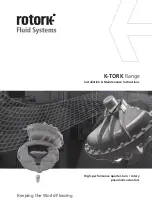
13
Keeping the World Flowing
5
HANDLING & LIFTING
5.1 Handling
The actuator is supplied packed on pallets suitably for normal
handling.
Handle the actuator with care to avoid damaging the
actuator assembly.
Never stack pallets.
Only trained and experienced personnel should
attempt to handle/lift the actuator.
5.2
Actuator lifting
For KT-30-SR, KT-40-SR, KT-50-DA, KT-60-DA and
KT-70-DA models, lift the actuator using appropriate chain or
sling attached to the eyebolt lifting interface, situated on the
top side of the actuator as shown in Figure 6. The eyebolts
have to be selected according to the threads on the eyebolt
interface. Eyebolt is not supplied with actuator.
Adjust the chain and/or the textile sling so that the actuator
remains horizontal.
• Actuator weight, dimensions and the centre of gravity
are contained within the documentation supplied for the
specific job. Personnel operating the actuator or parts of
it must consult all the documentation before performing
any operations.
• The lifting device and the sling must be suitable rated for
the actuator weight and dimensions.
• The sling must be in a proper working condition at all
times to prevent injuries and/or accidents. Do not use a
damaged sling.
• The sling must not be shortened with knots or bolts or
any other makeshift device.
• In no circumstances should piping or electric cabling be
used for lifting purposes. Drilling holes, welding eye bolts
or adding any other type of lifting device on the actuator
external surface is strictly forbidden.
• Do not lift the actuator/valve assembly by the actuator.
Only lift the actuator/valve assembly using the valve
lifting lugs.
• The actuator must be cut off from any source of energy.
• Avoid abrupt movements during lifting. Do not push or
pull the load when suspended.
• During lifting operations, do not handle the slings and/or
the actuator.
Figure 6: Actuator lifting points, highlighted by red circles.
Handling & Lifting














































